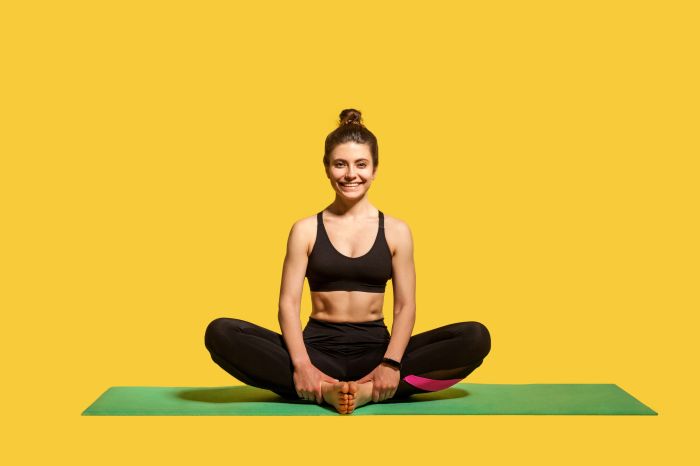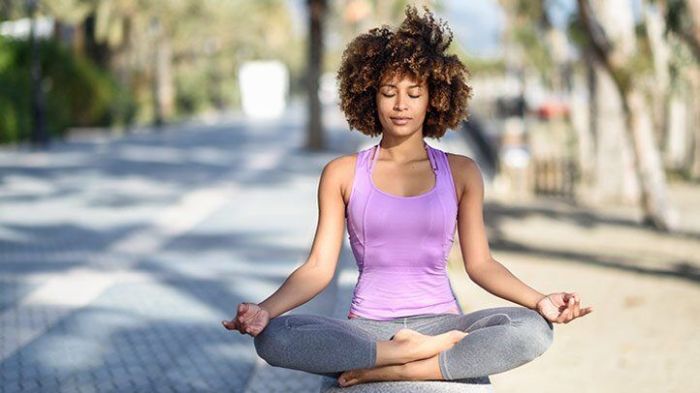Yoga for Beginners takes center stage, inviting you to explore the world of yoga with a fresh perspective. Get ready to embark on a journey filled with benefits, essential poses, and much more!
Introduction to Yoga for Beginners

Yoga is a holistic practice that combines physical postures, breathing techniques, and meditation to promote overall well-being. For beginners, yoga can offer numerous benefits such as improved flexibility, strength, balance, and stress relief.
The Importance of Starting a Yoga Practice as a Beginner
Starting a yoga practice as a beginner is essential to build a strong foundation and establish proper alignment and technique. It allows beginners to progress gradually, reduce the risk of injury, and gain confidence in their practice.
- Beginners can learn the fundamentals of yoga, including basic poses and breathing techniques.
- Starting early helps beginners develop a consistent practice and build strength and flexibility over time.
- Establishing a regular yoga routine can improve overall physical and mental health, leading to increased energy levels and reduced stress.
Common Misconceptions about Yoga for Beginners
Yoga is only for flexible people.
This is a common misconception as yoga is accessible to individuals of all fitness levels and body types. Beginners can start at their own pace and gradually increase flexibility through regular practice.
- Yoga is all about twisting into complex poses. In reality, yoga focuses on mindful movement, breath awareness, and relaxation.
- Beginners need expensive equipment to start yoga practice. All you really need is a yoga mat and comfortable clothing to begin your journey.
- Yoga is only for women. Yoga is a practice for everyone, regardless of gender, age, or fitness level.
Essential Equipment for Beginners

When starting your yoga journey as a beginner, it’s essential to have the right equipment to support your practice and enhance your experience. Here are some basic pieces of equipment you will need:
Yoga Mat
A yoga mat provides cushioning and support for your body during poses, as well as traction to prevent slipping. Look for a mat that is thick enough to support your joints but not too thick that it hinders balance.
Yoga Block
Yoga blocks help with proper alignment and provide support for poses that may be challenging for beginners. Choose a block made of lightweight but sturdy material for easy handling.
Yoga Strap, Yoga for Beginners
A yoga strap assists in reaching and holding poses that may be difficult due to flexibility limitations. Opt for a strap with a D-ring buckle for easy adjustments.
Yoga Blanket
A yoga blanket can provide additional support and cushioning during seated poses or as a prop for relaxation at the end of your practice. Look for a blanket made of soft, comfortable material.
Water Bottle
Staying hydrated during your practice is crucial, so make sure to have a water bottle nearby to sip on throughout your session. Choose a bottle that is easy to open and close, leak-proof, and holds an adequate amount of water.Remember to choose equipment that suits your needs and preferences, and don’t hesitate to experiment with different brands and styles to find what works best for you.
Basic Yoga Poses for Beginners: Yoga For Beginners
As a beginner in yoga, it’s essential to start with simple poses that help build strength, flexibility, and focus. Here are some basic yoga poses perfect for beginners.
Mountain Pose (Tadasana)
The Mountain Pose is a foundational pose in yoga that helps improve posture, balance, and concentration. Stand tall with your feet hip-width apart, arms relaxed by your sides, and shoulders rolled back. Engage your core, lengthen your spine, and breathe deeply.
Child’s Pose (Balasana)
Child’s Pose is a gentle resting pose that stretches the back, hips, thighs, and ankles. Start on your hands and knees, then sit back on your heels while reaching your arms forward. Rest your forehead on the mat and breathe deeply to relax and release tension.
Downward-Facing Dog (Adho Mukha Svanasana)
Downward-Facing Dog is a full-body stretch that strengthens the arms, shoulders, back, and legs. Begin on your hands and knees, then lift your hips up and back, forming an inverted V shape. Press your hands and feet into the mat, relax your head between your arms, and breathe deeply.
Warrior I (Virabhadrasana I)
Warrior I is a standing pose that helps build strength in the legs, shoulders, and core. Step one foot forward and bend your front knee at a 90-degree angle, keeping your back leg straight. Extend your arms overhead, palms facing each other, and gaze forward. Hold the pose while breathing deeply.
Breathing Techniques for Beginners
Breathing plays a crucial role in yoga practice as it helps to calm the mind, increase focus, and connect the body with the movements. For beginners, understanding and incorporating proper breathing techniques can enhance their overall yoga experience.
Deep Belly Breathing
- Start by sitting or lying comfortably with your eyes closed.
- Place one hand on your chest and the other on your belly.
- Inhale deeply through your nose, feeling your belly rise as you fill your lungs with air.
- Exhale slowly through your mouth, feeling your belly fall as you release the air.
- Repeat this deep belly breathing for a few minutes to relax and center yourself before starting your yoga practice.
Ujjayi Breathing
- Begin by sitting in a comfortable position with your eyes closed.
- Inhale deeply through your nose, slightly constricting the back of your throat to create a soft, ocean-like sound.
- Exhale slowly through your nose, again with that slight constriction in the throat to maintain the sound.
- Focus on matching the length of your inhales and exhales, making each breath smooth and controlled.
- Practice ujjayi breathing throughout your yoga routine to maintain a steady flow and enhance your mind-body connection.
Alternate Nostril Breathing
- Sit comfortably with your spine straight and your left hand resting on your left knee.
- Use your right thumb to close your right nostril and inhale deeply through your left nostril.
- Close your left nostril with your right ring finger, release the right nostril, and exhale slowly.
- Inhale through the right nostril, close it with your thumb, release the left nostril, and exhale slowly.
- Continue this alternate nostril breathing pattern for a few minutes to balance energy and focus the mind.
Creating a Practice Routine
To establish a consistent yoga practice routine, beginners should start by setting realistic goals and creating a weekly schedule to follow. This will help in developing a habit and making progress in their practice.
Setting Realistic Goals
Setting achievable goals is essential to stay motivated and track progress.
- Start with small goals like practicing yoga for 10 minutes daily.
- Gradually increase the duration and intensity of your practice as you progress.
- Focus on improving flexibility, strength, and mindfulness with each practice session.
Sample Weekly Practice Schedule
Having a structured schedule helps in making yoga a regular part of your routine.
| Day | Practice |
|---|---|
| Monday | 10 minutes of Sun Salutations |
| Tuesday | 15 minutes of basic poses and stretching |
| Wednesday | Rest day or gentle yoga practice |
| Thursday | 20 minutes of balance poses and breathing exercises |
| Friday | 10 minutes of meditation and relaxation |
| Saturday | 30 minutes of full-body yoga flow |
| Sunday | Rest day or self-practice session |
Benefits of Yoga for Beginners
Yoga offers a wide range of benefits for beginners, encompassing physical, mental, and emotional well-being. Through consistent practice, beginners can experience positive changes that promote overall health and vitality.
Physical Benefits
- Improved flexibility and range of motion
- Enhanced strength and muscle tone
- Better posture and balance
- Boosted immune system
Mental Benefits
- Reduced stress and anxiety levels
- Increased focus and concentration
- Improved mood and emotional well-being
- Enhanced relaxation and better sleep quality
Emotional Benefits
- Greater self-awareness and self-acceptance
- Increased confidence and self-esteem
- Enhanced ability to cope with challenges
- Improved relationships and social interactions